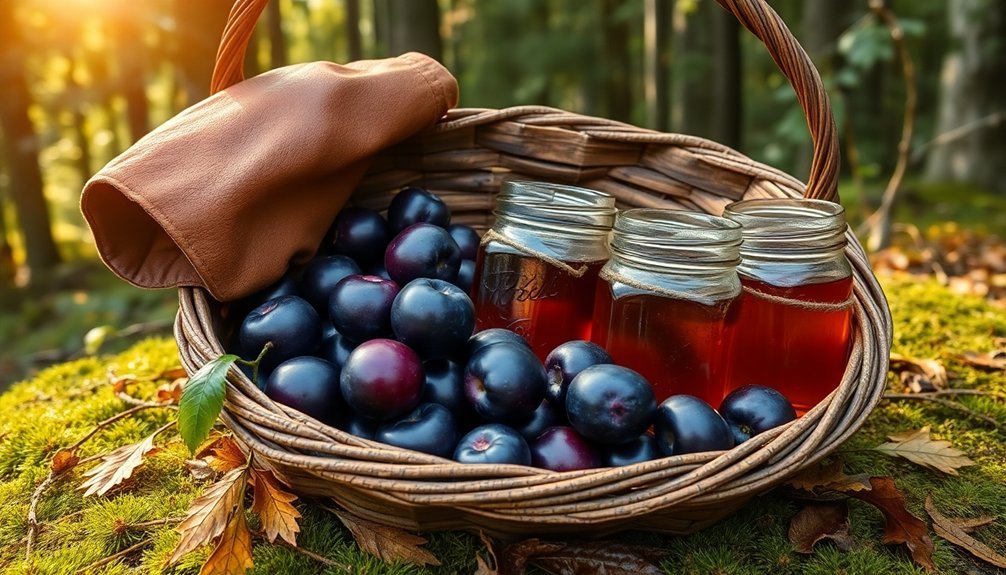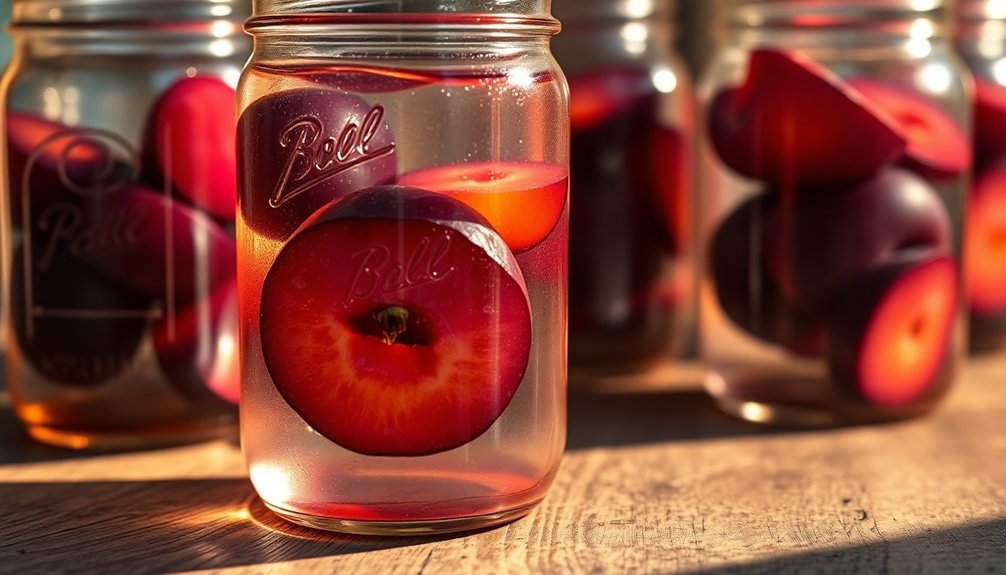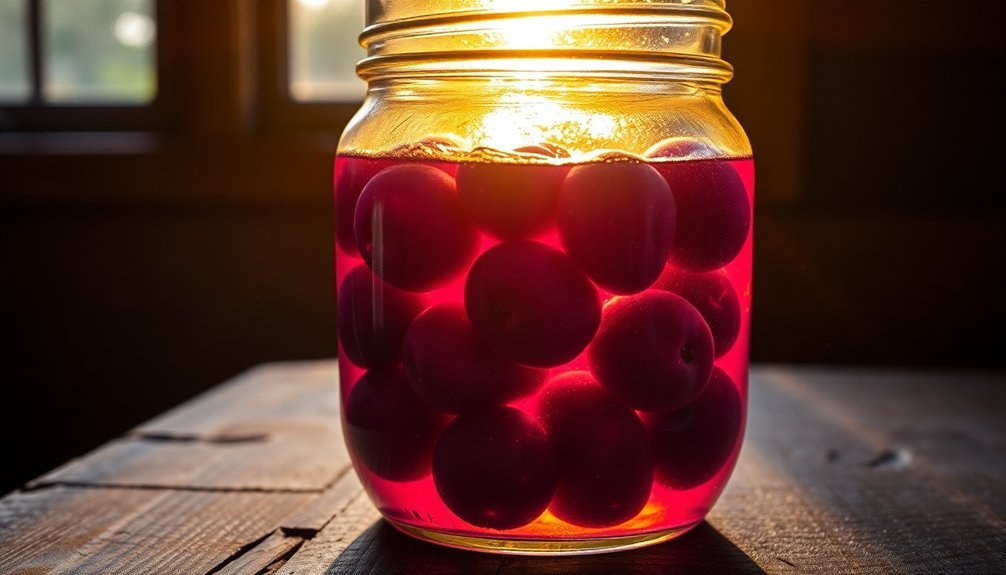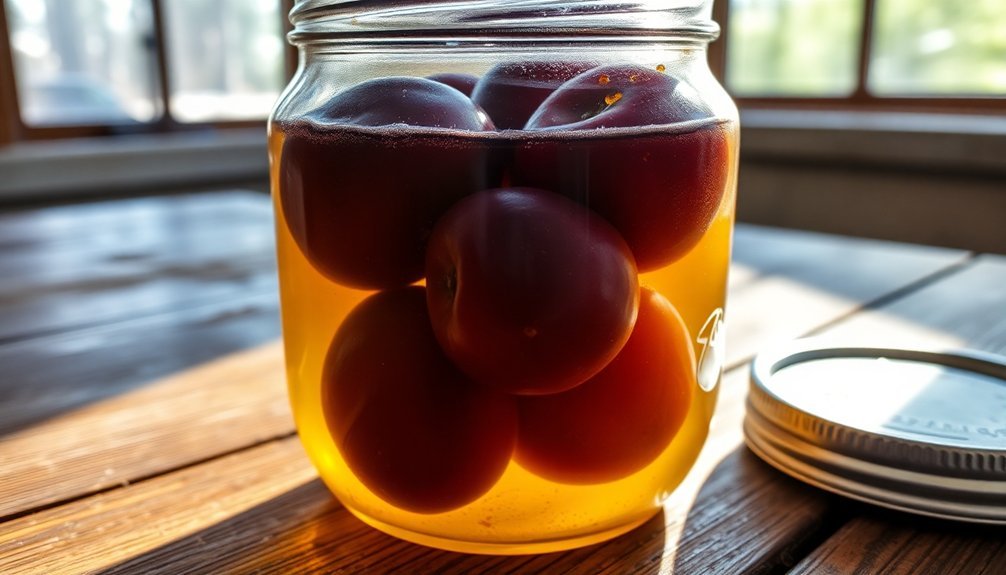To make authentic moonshine-soaked plums, you'll need fully ripe mountain plums that snap easily off the branch. Start by washing and pitting 10kg of plums, then crush them using a potato masher or wine bottle. Combine the crushed fruit with 4kg sugar and 24 liters of water using a 2:1 fruit-to-spirit ratio. Let the mixture ferment at 68-77°F for 2-5 weeks, watching for steady bubbling through the airlock. Once fermentation slows, strain the liquid and bottle it, leaving an inch of headspace. Your patience through this time-tested process will reveal the deepest mountain flavors.
Gathering Your Mountain Plums

Four key signs tell you when mountain plums are ready for harvest: they'll be fully colored, slightly soft to the touch, easily snap off the branch, and typically ripen 3-4 months after blossoming.
You'll need to act quickly once they're ripe, as they'll only stay on the tree for about two weeks before dropping.
For gathering your plums, you've got several effective methods to choose from. If you're dealing with lower branches, simply grasp the fruit and push up on the stem – it should snap off easily when ripe. A sweet fruity aroma will confirm your plums are at peak ripeness.
For higher branches, you'll want to use a telescoping pole fruit picker with a metal basket, or set up a tarp beneath the tree for the shake-and-catch method.
If you're harvesting early varieties like Santa Rosa or Cherry plums, you'll need to pick them over several weeks since they don't all ripen at once.
Later varieties, particularly prune plums that ripen in August, often mature simultaneously, letting you harvest them all at once.
Preparing The Fruit
Success with moonshine-soaked plums starts with proper preparation of your fruit. You'll need to begin by washing your plums thoroughly in water, removing any stems, leaves, or debris. Discard any plums showing signs of mold or excessive bruising – quality fruit leads to quality results.
Next, you'll want to pit your plums. While leaving the pits in can add an almond-like flavor, removing them prevents any potential cyanide leeching. Cut each plum in half and extract the pit.
Once you've completed this step, you'll need to crush the plums thoroughly. You can use a potato masher or even a clean wine bottle to achieve the right consistency. Using exactly five pounds of plums will yield the perfect balance of fruit flavor.
After crushing, combine your plums with sugar to help draw out the natural juices – this step is essential for proper fermentation. You'll want to stir the mixture well to guarantee even distribution.
Pour boiling water over your crushed plums to jumpstart the infusion process. Let this mixture rest for several days, making sure to swirl it daily for consistent extraction.
This preparation method guarantees your moonshine-soaked plums will develop the rich, complex flavors you're aiming for.
Sweet and Spirit Ratios

You'll want to balance your plums and moonshine using a 2:1 ratio of fruit to spirit, which lets the plums fully absorb the alcohol without becoming oversaturated.
For sweeter plums, you can reduce the sugar content in your soaking liquid, as the natural sugars will contribute enough sweetness to the final product. The natural yeast content on fresh plum skins adds complexity to the final flavor profile.
Your mixture should fill the container approximately 80% full, allowing enough space for the plums to expand as they soak up the spirit.
Balancing Sugar With Spirits
Getting the right balance between sugar and spirits is essential when making moonshine-soaked plums. You'll need to carefully measure your sugar additions to achieve the desired sweetness without overwhelming the natural plum flavors. Too much sugar can leave you with an overly sweet product that masks the subtle fruit notes.
When you're creating your infusion, start by combining your plums with a neutral spirit like vodka or moonshine. You'll want to add sugar gradually, tasting as you go to find the perfect balance that complements both the tartness of the plums and the strength of the spirit.
Keep in mind that the sugar doesn't just add sweetness – it helps extract flavors from the plums and mellows any bitter notes.
You'll need to let your mixture rest in a cool, dark place for several months to allow the flavors to properly combine. During this time, you can enhance the complexity by adding complementary aromatics like lemon peel, fennel, or coriander.
Remember to check your infusion periodically and adjust the sweetness if needed, as the flavors will continue to develop throughout the aging process.
Perfect Plum-to-Liquor Ratio
The art of creating perfectly infused moonshine-soaked plums hinges on mastering the correct fruit-to-liquor proportions.
You'll want to follow time-tested ratios that deliver the best flavor and ideal alcohol content. For a standard 25-liter batch, you're looking at using 10 kg of ripe plums combined with 4 kg of sugar and 24 liters of water – a ratio that's proven to deliver consistent results.
For the best outcome, consider these essential ratio guidelines:
- Start with a 1:1:5 ratio (fruit:sugar:water) for a balanced baseline
- Use 2 kg fruit, 1 kg sugar, and 5 liters water per 5-liter batch
- Increase fruit content if you want stronger plum flavor
- Adjust sugar based on your plums' natural sweetness
You'll need to dissolve your sugar in warm (not hot) water before adding it to your plum mash.
If you're working with particularly sweet plums, you can reduce the sugar content accordingly.
For enhanced juice extraction, try freezing and thawing your plums before use. This method breaks down the cell walls and makes the fruit's sugars more accessible during fermentation.
Adjusting For Plum Sweetness
Building on our ratio fundamentals, adjusting for plum sweetness requires careful attention to both natural fruit sugars and added sweeteners.
You'll want to select fully ripened plums, particularly Italian or European varieties, as they provide ideal natural sugar content for fermentation.
To determine your sugar adjustments, assess your plums' sweetness first. If you're using particularly sweet plums, you might skip additional sugar entirely. However, for tarter fruits, you'll need to supplement with sugar to achieve proper fermentation and desired ABV.
Start with the proven ratio of 2 kg plums to 1 kg sugar to 5 liters water, adjusting as needed.
When adding sugar, dissolve it in warm water before mixing it into your plum mash. This guarantees even distribution throughout your mixture.
Don't exceed a 1:1:5 ratio of sugar to fruit to water, as this could lead to over-fermentation. If you're freezing your plums beforehand, you'll find they release more natural sugars, potentially reducing your need for added sweeteners.
The Fermentation Magic
While you can rely on wild yeast that naturally occurs on plum skins, using added distiller's or wine yeast provides more consistent and predictable fermentation results.
You'll need to maintain a steady temperature between 68-77°F throughout the process, as fluctuations can stress the yeast and affect your final product.
Setting up your fermentation container in a temperature-controlled environment, like a basement or climate-controlled room, helps guarantee ideal yeast activity and complete sugar conversion.
Wild Yeast vs. Added
Magic happens in two distinct ways when fermenting moonshine-soaked plums: through wild yeast that naturally exists on the fruit's skin or via carefully selected commercial yeast strains.
If you're going the wild yeast route, you'll need to preserve the white, waxy coating on your plums – that's where the natural magic lives. Don't wash the fruit, as this coating contains everything you'll need for fermentation to begin.
For those seeking more control, adding commercial yeast offers predictability and consistency. You'll want to use white wine or distiller's yeast, avoiding bread yeast which can compromise your final product.
Here's what you need to know about both methods:
- Wild yeast fermentation takes 2-5 weeks, while added yeast typically works faster.
- Natural fermentation requires no additional sugar or water, but you'll need specific ratios with added yeast (1:1:5 fruit:sugar:water).
- Wild yeast produces unique, location-specific flavors, but results can be unpredictable.
- Added yeast allows for better control but requires proper hydration at 30°C.
Monitor both methods carefully for mold – white mold can be removed, but black mold means you'll need to start over.
Temperature Control Essentials
Whether you're working with wild or added yeast, maintaining the right temperature can make or break your moonshine-soaked plums. You'll want to keep your fermentation between 68-77°F (20-25°C) for ideal results. If you're using distillers' active dry yeast, aim for 78°F (25.6°C).
To control temperature effectively, wrap your fermenter in a wet towel and place it in a water-filled container. You can add reusable ice packs when needed or use a submersible aquarium pump to maintain consistent temperatures. For colder environments, consider using a heating pad with proper insulation.
Remember that fermentation generates its own heat, so the temperature inside your fermenter will likely be higher than the room temperature. Monitor this carefully using a probe thermometer and thermowell.
Don't let higher temperatures tempt you – while they'll speed up fermentation, they'll also create unwanted flavors in your final product.
Change your cooling water regularly to prevent it from becoming slimy, and make sure your fermenter has enough headspace to prevent overflow.
Check your fermentation daily, adjusting temperature controls as needed. Consistent temperature means consistent results, leading to better-tasting moonshine-soaked plums.
Bottling Your Mountain Treasure

The final step in crafting your plum moonshine requires careful attention to bottling and storage techniques. Before you begin, verify all your equipment is thoroughly cleaned and sanitized to prevent any contamination that could spoil your batch.
You'll want to filter your aged moonshine thoroughly through a fine mesh or cheesecloth to remove any lingering sediment. This extra step guarantees your final product maintains its clarity and professional appearance.
Once filtered, you're ready to transfer your mountain treasure into sanitized bottles.
Here's your essential bottling checklist:
- Filter the aged moonshine through a fine-mesh strainer or cheesecloth until completely clear
- Fill your sanitized bottles, leaving about an inch of headspace at the top
- Seal bottles immediately with clean, airtight caps or corks
- Label each bottle with the production date and batch number
Store your bottled moonshine in a cool, dark place to maintain its quality. While your spirits will keep indefinitely, the best storage temperature ranges between 55-65°F.
Remember to position bottles upright to minimize the liquid's contact with the cap or cork, reducing the risk of contamination.
Patience Brings Perfect Results
Patience plays an essential role in crafting exceptional plum moonshine, as rushing any stage of the process can compromise your final product.
You'll find that letting your plums ripen for a few days before processing makes them easier to mash and enriches their flavor profile.
When you're monitoring fermentation, don't rush the process. Keep your fermenting mash in a dark, temperature-controlled environment between 68-77°F, and let it work its magic for one to three weeks.
You'll know it's progressing well when you see steady bubbling through your airlock. Watch for any white mold forming on top and remove it promptly if it appears.
Pay attention to the signs that tell you when fermentation is complete. The bubbling will gradually slow down and eventually stop.
Don't move to the next stage until you're certain fermentation has finished. If you notice the process stalling, check the pH levels and adjust if necessary.
When straining your fermented mash, take your time to extract every bit of liquid from the pulp – this attention to detail will reward you with better yields and clearer wash for distillation.
Frequently Asked Questions
Can I Substitute Moonshine With Other Spirits for This Recipe?
Yes, you can substitute moonshine with whiskey, brandy, or Lillet Blanc. You'll want to match the spirit's quantity in your recipe. Each alternative will bring its own unique flavor to your finished dish.
What Signs Indicate the Plums Have Gone Bad During Fermentation?
Watch for off odors, visible mold, excessive slime, or unusual cloudiness. You'll know something's wrong if you see fruit flies, the mixture smells vinegary, or there's abnormal sediment at the bottom.
How Long Will Moonshine-Soaked Plums Last When Properly Stored?
When you store them properly in an airtight container and keep them fully submerged in moonshine, your plums can last 6-12 months. You'll get the best flavor within the first three months of storage.
Does the Alcohol Content Change if I Use Different Plum Varieties?
Yes, your alcohol content will vary with different plum varieties. Higher-sugar plums like Italian prunes will absorb more alcohol, while varieties with less sugar content won't soak up as much moonshine.
Can I Reuse the Leftover Moonshine for a Second Batch?
You can't reuse leftover moonshine effectively for another batch. Instead, you'll want to reuse the mash by adding fresh ingredients, maintaining active yeast, and following proper fermentation temperatures for the best results.
In Summary
You've created something special by following this time-tested mountain tradition. Your moonshine-soaked plums will need at least six weeks to reach their peak flavor, but they'll keep beautifully for up to a year. Store your jars in a cool, dark place and resist opening them too early. When you're ready, you'll discover the perfect blend of sweet fruit and mountain spirit that generations have enjoyed.





Leave a Reply